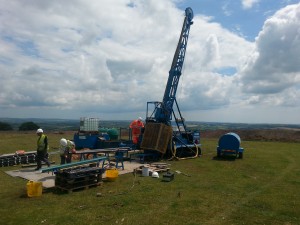 When Meridian Drilling took on its recent UK project at the Wolf Minerals tungsten and tin mine near Hemerdon in Devon, it drew on experience gained through projects in Europe and active mine sites in Africa.
When Meridian Drilling took on its recent UK project at the Wolf Minerals tungsten and tin mine near Hemerdon in Devon, it drew on experience gained through projects in Europe and active mine sites in Africa.
The contract, at the Drakelands Mine Project, saw Meridian drilling 1,200m comprising of six 200m holes, to conduct a geotechnical assessment of the pit wall stability.
Jeremy Moore, MD of Meridian Drilling said: “As a company our most significant projects have been overseas, but our headquarters have remained in the UK. “This was a great project for us to work on, not just because it was in our home country, but because of its global significance.”
Diamond core drilling Drilling holes of such depth in hard rock, using diamond wireline core drilling demanded a rig with a high rotation speed. The Meridian team also used angle drilling, not something that most UK geotechnical rigs are set up for. Meridian Drilling MD Jeremy Moore explained that the Atlas Copco CS14 rig was customized specifically for the job: “The CS14 was stripped and fully rebuilt by Euro Repair after returning from four years on the Allana Potash Project in Ethiopia.
It was also track mounted to cope with the ground conditions in Devon and adapted to include fully compliant UK HSE guarding.” Meridian provided oriented core using the Reflex ACT 2 digital orientation tool. In addition triple tube drilling provided high quality and well presented core, allowing the geologists to better examine the rock mass and associated discontinuities.
The team also conducted packer testing using wireline single and double packers to assess the permeability of the rock mass and installed groundwater monitoring into the holes. Challenges Meridian’s contract was to provide the information to allow the possibility of a steeper pit wall design and, in turn, deeper mining there-by potentially increasing the life of the mine.
Drilling supervisor Bill Pullen explained that, as with all sites, there were some challenges: “The monitoring installation was quite simple, namely a 1 inch plastic pipe for measuring the depth of water,” he said.
“We had planned to grout the bottom of the holes but were unable to do so as the ground conditions meant that the cement washed away as fast as we could put it in.
“As an alternative we had to run Pea Gravel, which was a slow and difficult process. The hole was at an angle, and the gravel had a tendency to start bridging.”
The team fed the Pea Gravel through the rods from the bottom up, before installing the monitoring pipe in place at the required depth. More gravel was run around the installation to near surface before it was sealed and the hole capped off with cement and a cover installed. HSE While Meridian is familiar with working on active mine sites in Ethiopia and Republic of Congo, it brought in additional HSE safeguards for the Hemerdon site.
Moore said: “Before starting work our employees also completed training accredited by the Mineral Products Qualification Council to reinforce our standards and ensure safe working in a quarry environment.”
Added to this, members of the Meridian team took a four-wheel driving test before they were allowed to drive on site, and were given a half-day induction by Wolf Minerals prior to entering the site. Once fully operational, the Hemerdon project is expected to supply 3.5per cent of global tungsten.
The mine is expected to have a minimum 10-year lifespan. It is believed it may have potential for longer, but this would require new planning permission.
This was the second recent UK project for Meridian Drilling. The UK-headquartered recently worked with Treliver Minerals on projects near St Columb, Cornwall to explore for tin.
 Latest Tweets
Latest Tweets